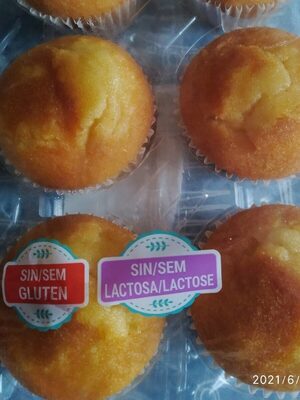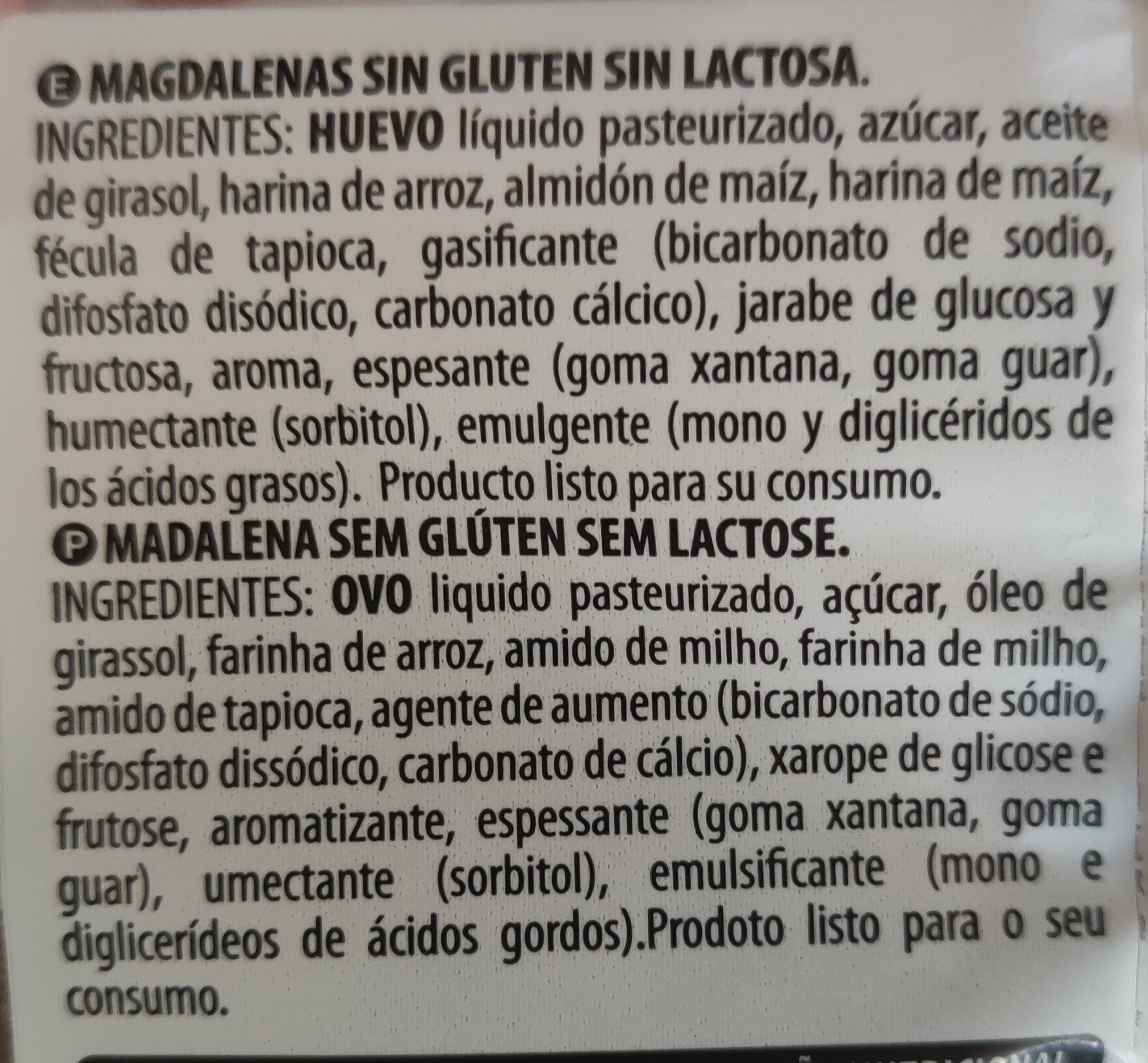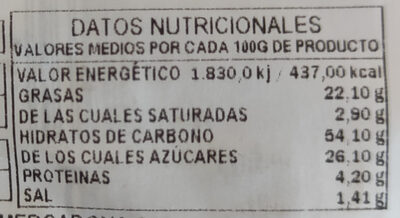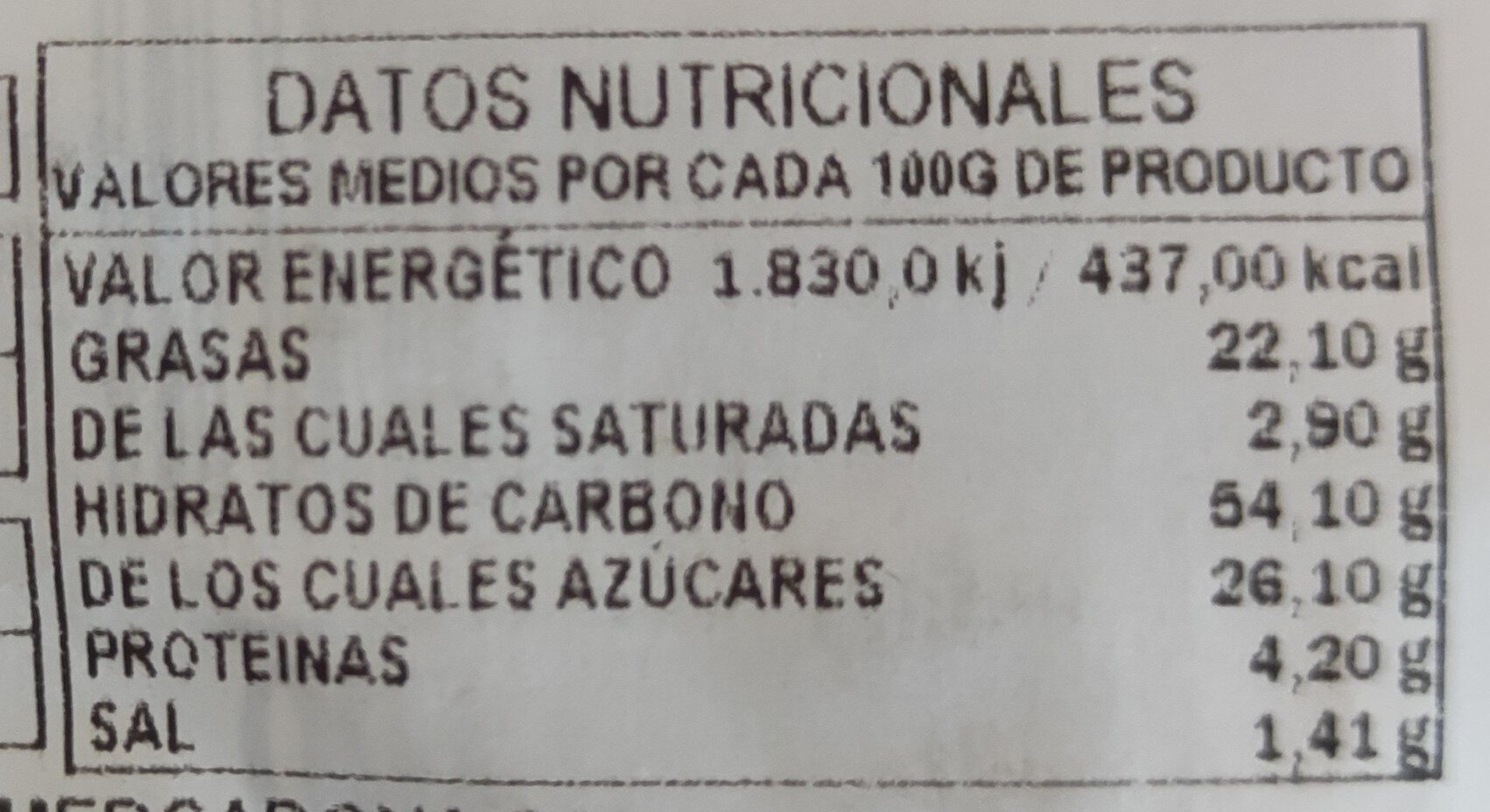Help us make food transparency the norm!
As a non-profit organization, we depend on your donations to continue informing consumers around the world about what they eat.
The food revolution starts with you!
Madalena SG sin lactosa - Mercadona - 300g
Madalena SG sin lactosa - Mercadona - 300g
This product page is not complete. You can help to complete it by editing it and adding more data from the photos we have, or by taking more photos using the app for Android or iPhone/iPad. Thank you!
×
Barra-kodea: 236847280000100700002105
Kopurua: 300g
Ontziratzea: es:Plástico papel
Markak: Mercadona
Kategoriak: en:Snacks, en:Sweet snacks, en:Biscuits and cakes, Gozopil, en:Galletas y pasteles Pasteles Productos sin gluten Magdalenas
Etiketak, ziurtagiriak, sariak: en:No gluten, en:Gluten-freeSin lactosa
Manufacturing or processing places: Tavernes Blanques
Saltzen diren herrialdeak: Espainia
Matching with your preferences
Health
Osagaiak
-
48 ingredients
Gaztelania: Español: MAGDALENAS SIN GLUTEN SIN-LACTOSA. INGREDIENTES: HUEVO líquido pasteurizado, azúcar, aceite de girasol, harina de arroz, almidón de maíz, harina de maíz, fécula de tapioca, gasificante (bicarbonato de sodio, difosfato disódico, carbonato cálcico), jarabe de glucosa y fructosa, aroma, espesante (goma xantana, goma guar), humectante (sorbitol), emulgente (mono y diglicéridos de los ácidos grasos). Producto listo para su consumo. Portuges: MADALENA SEM GLÚTEN SEM-LACTOSE. INGREDIENTES: OVO liquido pasteurizado, açúcar, óleo de girassol, farinha de arroz, amido de milho, farinha de milho, amido de tapioca, agente de aumento (bicarbonato de sódio, difosfato dissódico, carbonato de cálcio), xarope de glicose e frutose, aromatizante, espessante (goma xantana, goma guar), umectante (sorbitol), emulsificante (mono e diglicerídeos de ácidos gordos).Prodoto listo para o seu consumo.Alergenoak: en:Eggs, en:MilkAztarnak: en:Eggs
Food processing
-
Ultra processed foods
Elements that indicate the product is in the 4 - Ultra prozesatutako elikagaiak eta edariak group:
- Gehigarria: E412
- Gehigarria: E415
- Gehigarria: E420
- Gehigarria: E450
- Gehigarria: E471
- Osagaia: Emulsifier
- Osagaia: Flavouring
- Osagaia: Glukosa
- Osagaia: Humectant
- Osagaia: Thickener
Food products are classified into 4 groups according to their degree of processing:
- Prozesatu gabeko edo ahalik eta gutxien prozesatutako elikagaiak
- Sukaldaritzako osagaiak prozesatu
- Prozesatutako jakiak
- Ultra processed foods
The determination of the group is based on the category of the product and on the ingredients it contains.
Gehigarriak
-
E412
Guar gum: Guar gum, also called guaran, is a galactomannan polysaccharide extracted from guar beans that has thickening and stabilizing properties useful in the food, feed and industrial applications. The guar seeds are mechanically dehusked, hydrated, milled and screened according to application. It is typically produced as a free-flowing, off-white powder.Source: Wikipedia (Ingeles)
-
E415
Xanthan gum: Xanthan gum -- is a polysaccharide with many industrial uses, including as a common food additive. It is an effective thickening agent and stabilizer to prevent ingredients from separating. It can be produced from simple sugars using a fermentation process, and derives its name from the species of bacteria used, Xanthomonas campestris.Source: Wikipedia (Ingeles)
-
E420
Sorbitol: Sorbitol --, less commonly known as glucitol --, is a sugar alcohol with a sweet taste which the human body metabolizes slowly. It can be obtained by reduction of glucose, which changes the aldehyde group to a hydroxyl group. Most sorbitol is made from corn syrup, but it is also found in nature, for example in apples, pears, peaches, and prunes. It is converted to fructose by sorbitol-6-phosphate 2-dehydrogenase. Sorbitol is an isomer of mannitol, another sugar alcohol; the two differ only in the orientation of the hydroxyl group on carbon 2. While similar, the two sugar alcohols have very different sources in nature, melting points, and uses.Source: Wikipedia (Ingeles)
-
E471
Mono- and diglycerides of fatty acids: Mono- and diglycerides of fatty acids -E471- refers to a food additive composed of diglycerides and monoglycerides which is used as an emulsifier. This mixture is also sometimes referred to as partial glycerides.Source: Wikipedia (Ingeles)
-
E500
Sodium carbonate: Sodium carbonate, Na2CO3, -also known as washing soda, soda ash and soda crystals, and in the monohydrate form as crystal carbonate- is the water-soluble sodium salt of carbonic acid. It most commonly occurs as a crystalline decahydrate, which readily effloresces to form a white powder, the monohydrate. Pure sodium carbonate is a white, odorless powder that is hygroscopic -absorbs moisture from the air-. It has a strongly alkaline taste, and forms a moderately basic solution in water. Sodium carbonate is well known domestically for its everyday use as a water softener. Historically it was extracted from the ashes of plants growing in sodium-rich soils, such as vegetation from the Middle East, kelp from Scotland and seaweed from Spain. Because the ashes of these sodium-rich plants were noticeably different from ashes of timber -used to create potash-, they became known as "soda ash". It is synthetically produced in large quantities from salt -sodium chloride- and limestone by a method known as the Solvay process. The manufacture of glass is one of the most important uses of sodium carbonate. Sodium carbonate acts as a flux for silica, lowering the melting point of the mixture to something achievable without special materials. This "soda glass" is mildly water-soluble, so some calcium carbonate is added to the melt mixture to make the glass produced insoluble. This type of glass is known as soda lime glass: "soda" for the sodium carbonate and "lime" for the calcium carbonate. Soda lime glass has been the most common form of glass for centuries. Sodium carbonate is also used as a relatively strong base in various settings. For example, it is used as a pH regulator to maintain stable alkaline conditions necessary for the action of the majority of photographic film developing agents. It acts as an alkali because when dissolved in water, it dissociates into the weak acid: carbonic acid and the strong alkali: sodium hydroxide. This gives sodium carbonate in solution the ability to attack metals such as aluminium with the release of hydrogen gas.It is a common additive in swimming pools used to raise the pH which can be lowered by chlorine tablets and other additives which contain acids. In cooking, it is sometimes used in place of sodium hydroxide for lyeing, especially with German pretzels and lye rolls. These dishes are treated with a solution of an alkaline substance to change the pH of the surface of the food and improve browning. In taxidermy, sodium carbonate added to boiling water will remove flesh from the bones of animal carcasses for trophy mounting or educational display. In chemistry, it is often used as an electrolyte. Electrolytes are usually salt-based, and sodium carbonate acts as a very good conductor in the process of electrolysis. In addition, unlike chloride ions, which form chlorine gas, carbonate ions are not corrosive to the anodes. It is also used as a primary standard for acid-base titrations because it is solid and air-stable, making it easy to weigh accurately.Source: Wikipedia (Ingeles)
-
E500ii - Sodio hidrogenokarbonato
Sodium carbonate: Sodium carbonate, Na2CO3, -also known as washing soda, soda ash and soda crystals, and in the monohydrate form as crystal carbonate- is the water-soluble sodium salt of carbonic acid. It most commonly occurs as a crystalline decahydrate, which readily effloresces to form a white powder, the monohydrate. Pure sodium carbonate is a white, odorless powder that is hygroscopic -absorbs moisture from the air-. It has a strongly alkaline taste, and forms a moderately basic solution in water. Sodium carbonate is well known domestically for its everyday use as a water softener. Historically it was extracted from the ashes of plants growing in sodium-rich soils, such as vegetation from the Middle East, kelp from Scotland and seaweed from Spain. Because the ashes of these sodium-rich plants were noticeably different from ashes of timber -used to create potash-, they became known as "soda ash". It is synthetically produced in large quantities from salt -sodium chloride- and limestone by a method known as the Solvay process. The manufacture of glass is one of the most important uses of sodium carbonate. Sodium carbonate acts as a flux for silica, lowering the melting point of the mixture to something achievable without special materials. This "soda glass" is mildly water-soluble, so some calcium carbonate is added to the melt mixture to make the glass produced insoluble. This type of glass is known as soda lime glass: "soda" for the sodium carbonate and "lime" for the calcium carbonate. Soda lime glass has been the most common form of glass for centuries. Sodium carbonate is also used as a relatively strong base in various settings. For example, it is used as a pH regulator to maintain stable alkaline conditions necessary for the action of the majority of photographic film developing agents. It acts as an alkali because when dissolved in water, it dissociates into the weak acid: carbonic acid and the strong alkali: sodium hydroxide. This gives sodium carbonate in solution the ability to attack metals such as aluminium with the release of hydrogen gas.It is a common additive in swimming pools used to raise the pH which can be lowered by chlorine tablets and other additives which contain acids. In cooking, it is sometimes used in place of sodium hydroxide for lyeing, especially with German pretzels and lye rolls. These dishes are treated with a solution of an alkaline substance to change the pH of the surface of the food and improve browning. In taxidermy, sodium carbonate added to boiling water will remove flesh from the bones of animal carcasses for trophy mounting or educational display. In chemistry, it is often used as an electrolyte. Electrolytes are usually salt-based, and sodium carbonate acts as a very good conductor in the process of electrolysis. In addition, unlike chloride ions, which form chlorine gas, carbonate ions are not corrosive to the anodes. It is also used as a primary standard for acid-base titrations because it is solid and air-stable, making it easy to weigh accurately.Source: Wikipedia (Ingeles)
Ingredients analysis
-
en:May contain palm oil
Ingredients that may contain palm oil: E471
-
en:Non-vegan
Non-vegan ingredients: en:Liquid eggSome ingredients could not be recognized.
We need your help!
You can help us recognize more ingredients and better analyze the list of ingredients for this product and others:
- Edit this product page to correct spelling mistakes in the ingredients list, and/or to remove ingredients in other languages and sentences that are not related to the ingredients.
- Add new entries, synonyms or translations to our multilingual lists of ingredients, ingredient processing methods, and labels.
If you would like to help, join the #ingredients channel on our Slack discussion space and/or learn about ingredients analysis on our wiki. Thank you!
-
en:Vegetarian status unknown
Unrecognized ingredients: es:espanol, es:magdalenas-sin-lactosa, es:ingredientes, es:producto-listo-para-su-consumo, es:portuges, es:madalena-sem-gluten-sem-lactose, es:ingredientes, es:ovo-liquido-pasteurizado, es:acucar, es:oleo-de-girassol, es:farinha-de-arroz, es:amido-de-milho, es:farinha-de-milho, es:amido-de-tapioca, es:agente-de-aumento, es:difosfato-dissodico, es:xarope-de-glicose-y-frutose, es:espessante, es:umectante, es:mono-y-diglicerideos-de-acidos-gordos, es:prodoto-listo-para-y-seu-consumoSome ingredients could not be recognized.
We need your help!
You can help us recognize more ingredients and better analyze the list of ingredients for this product and others:
- Edit this product page to correct spelling mistakes in the ingredients list, and/or to remove ingredients in other languages and sentences that are not related to the ingredients.
- Add new entries, synonyms or translations to our multilingual lists of ingredients, ingredient processing methods, and labels.
If you would like to help, join the #ingredients channel on our Slack discussion space and/or learn about ingredients analysis on our wiki. Thank you!
-
Details of the analysis of the ingredients
We need your help!
Some ingredients could not be recognized.
We need your help!
You can help us recognize more ingredients and better analyze the list of ingredients for this product and others:
- Edit this product page to correct spelling mistakes in the ingredients list, and/or to remove ingredients in other languages and sentences that are not related to the ingredients.
- Add new entries, synonyms or translations to our multilingual lists of ingredients, ingredient processing methods, and labels.
If you would like to help, join the #ingredients channel on our Slack discussion space and/or learn about ingredients analysis on our wiki. Thank you!
es: Español (MAGDALENAS SIN-LACTOSA, INGREDIENTES), HUEVO líquido, azúcar, aceite de girasol, harina de arroz, almidón de maíz, harina de maíz, fécula de tapioca, gasificante (bicarbonato de sodio, difosfato disódico, carbonato cálcico), jarabe de glucosa y fructosa, aroma, espesante (goma xantana, goma guar), humectante (sorbitol), emulgente (mono- y diglicéridos de los ácidos grasos), Producto listo para su consumo, Portuges (MADALENA SEM GLÚTEN SEM-LACTOSE, INGREDIENTES), OVO liquido pasteurizado, açúcar, óleo de girassol, farinha de arroz, amido de milho, farinha de milho, amido de tapioca, agente de aumento (bicarbonato de sódio, difosfato dissódico, carbonato de cálcio), xarope de glicose y frutose, aromatizante, espessante (goma xantana, goma guar), umectante (sorbitol), emulsificante (mono- y diglicerídeos de ácidos gordos), Prodoto listo para y seu consumo- Español -> es:espanol - percent_min: 3.33333333333333 - percent_max: 100
- MAGDALENAS SIN-LACTOSA -> es:magdalenas-sin-lactosa - labels: en:no-gluten - percent_min: 1.66666666666667 - percent_max: 100
- INGREDIENTES -> es:ingredientes - percent_min: 0 - percent_max: 50
- HUEVO líquido -> en:liquid-egg - vegan: no - vegetarian: yes - ciqual_food_code: 22000 - percent_min: 0 - percent_max: 50
- azúcar -> en:sugar - vegan: yes - vegetarian: yes - ciqual_proxy_food_code: 31016 - percent_min: 0 - percent_max: 26.1
- aceite de girasol -> en:sunflower-oil - vegan: yes - vegetarian: yes - from_palm_oil: no - ciqual_food_code: 17440 - percent_min: 0 - percent_max: 25
- harina de arroz -> en:rice-flour - vegan: yes - vegetarian: yes - ciqual_food_code: 9520 - percent_min: 0 - percent_max: 20
- almidón de maíz -> en:corn-starch - vegan: yes - vegetarian: yes - ciqual_food_code: 9510 - percent_min: 0 - percent_max: 16.6666666666667
- harina de maíz -> en:corn-flour - vegan: yes - vegetarian: yes - ciqual_food_code: 9545 - percent_min: 0 - percent_max: 14.2857142857143
- fécula de tapioca -> en:tapioca - vegan: yes - vegetarian: yes - ciqual_proxy_food_code: 9510 - percent_min: 0 - percent_max: 12.5
- gasificante -> en:raising-agent - percent_min: 0 - percent_max: 11.1111111111111
- bicarbonato de sodio -> en:e500ii - vegan: yes - vegetarian: yes - percent_min: 0 - percent_max: 11.1111111111111
- difosfato disódico -> en:e450i - vegan: yes - vegetarian: yes - percent_min: 0 - percent_max: 5.55555555555556
- carbonato cálcico -> en:e170i - vegan: maybe - vegetarian: maybe - percent_min: 0 - percent_max: 3.7037037037037
- jarabe de glucosa y fructosa -> en:glucose-fructose-syrup - vegan: yes - vegetarian: yes - ciqual_food_code: 31077 - percent_min: 0 - percent_max: 10
- aroma -> en:flavouring - vegan: maybe - vegetarian: maybe - percent_min: 0 - percent_max: 5
- espesante -> en:thickener - percent_min: 0 - percent_max: 5
- goma xantana -> en:e415 - vegan: yes - vegetarian: yes - percent_min: 0 - percent_max: 5
- goma guar -> en:e412 - vegan: yes - vegetarian: yes - percent_min: 0 - percent_max: 2.5
- humectante -> en:humectant - percent_min: 0 - percent_max: 5
- sorbitol -> en:e420 - vegan: yes - vegetarian: yes - percent_min: 0 - percent_max: 5
- emulgente -> en:emulsifier - percent_min: 0 - percent_max: 5
- mono- y diglicéridos de los ácidos grasos -> en:e471 - vegan: maybe - vegetarian: maybe - from_palm_oil: maybe - percent_min: 0 - percent_max: 5
- Producto listo para su consumo -> es:producto-listo-para-su-consumo - percent_min: 0 - percent_max: 5
- Portuges -> es:portuges - percent_min: 0 - percent_max: 5
- MADALENA SEM GLÚTEN SEM-LACTOSE -> es:madalena-sem-gluten-sem-lactose - percent_min: 0 - percent_max: 5
- INGREDIENTES -> es:ingredientes - percent_min: 0 - percent_max: 2.5
- OVO liquido pasteurizado -> es:ovo-liquido-pasteurizado - percent_min: 0 - percent_max: 5
- açúcar -> es:acucar - percent_min: 0 - percent_max: 5
- óleo de girassol -> es:oleo-de-girassol - percent_min: 0 - percent_max: 5
- farinha de arroz -> es:farinha-de-arroz - percent_min: 0 - percent_max: 5
- amido de milho -> es:amido-de-milho - percent_min: 0 - percent_max: 4.76190476190476
- farinha de milho -> es:farinha-de-milho - percent_min: 0 - percent_max: 4.54545454545455
- amido de tapioca -> es:amido-de-tapioca - percent_min: 0 - percent_max: 4.34782608695652
- agente de aumento -> es:agente-de-aumento - percent_min: 0 - percent_max: 4.16666666666667
- bicarbonato de sódio -> en:e500ii - vegan: yes - vegetarian: yes - percent_min: 0 - percent_max: 4.16666666666667
- difosfato dissódico -> es:difosfato-dissodico - percent_min: 0 - percent_max: 2.08333333333333
- carbonato de cálcio -> en:e170i - vegan: maybe - vegetarian: maybe - percent_min: 0 - percent_max: 1.38888888888889
- xarope de glicose y frutose -> es:xarope-de-glicose-y-frutose - percent_min: 0 - percent_max: 4
- aromatizante -> en:flavouring - vegan: maybe - vegetarian: maybe - percent_min: 0 - percent_max: 3.84615384615385
- espessante -> es:espessante - percent_min: 0 - percent_max: 3.7037037037037
- goma xantana -> en:e415 - vegan: yes - vegetarian: yes - percent_min: 0 - percent_max: 3.7037037037037
- goma guar -> en:e412 - vegan: yes - vegetarian: yes - percent_min: 0 - percent_max: 1.85185185185185
- umectante -> es:umectante - percent_min: 0 - percent_max: 3.57142857142857
- sorbitol -> en:e420 - vegan: yes - vegetarian: yes - percent_min: 0 - percent_max: 3.57142857142857
- emulsificante -> en:emulsifier - percent_min: 0 - percent_max: 3.44827586206897
- mono- y diglicerídeos de ácidos gordos -> es:mono-y-diglicerideos-de-acidos-gordos - percent_min: 0 - percent_max: 3.44827586206897
- Prodoto listo para y seu consumo -> es:prodoto-listo-para-y-seu-consumo - percent_min: 0 - percent_max: 3.33333333333333
Elikadura
-
Poor nutritional quality
⚠ ️Abisua: zuntz kopurua ez dago zehaztuta, ezin izan dute kontuan izan kalifikaziorako izan dezaketen ekarpen positiboa.⚠ ️Warning: the amount of fruits, vegetables and nuts is not specified on the label, it was estimated from the list of ingredients: 0This product is not considered a beverage for the calculation of the Nutri-Score.
Positive points: 0
- Proteinak: 2 / 5 (balioa: 4.2, rounded value: 4.2)
- Fiber: 0 / 5 (balioa: 0, rounded value: 0)
- Fruits, vegetables, nuts, and colza/walnut/olive oils: 0 / 5 (balioa: 0, rounded value: 0)
Negative points: 18
- Energia: 5 / 10 (balioa: 1830, rounded value: 1830)
- Azukreak: 5 / 10 (balioa: 26.1, rounded value: 26.1)
- Gantz saturatua: 2 / 10 (balioa: 2.9, rounded value: 2.9)
- Sodioa: 6 / 10 (balioa: 564, rounded value: 564)
The points for proteins are not counted because the negative points are greater or equal to 11.
Nutritional score: (18 - 0)
Nutri-Score:
-
Nutrient levels
-
Koipe in high quantity (22.1%)
What you need to know- A high consumption of fat, especially saturated fats, can raise cholesterol, which increases the risk of heart diseases.
Recommendation: Limit the consumption of fat and saturated fat- Choose products with lower fat and saturated fat content.
-
Gantz-azido ase in moderate quantity (2.9%)
What you need to know- A high consumption of fat, especially saturated fats, can raise cholesterol, which increases the risk of heart diseases.
Recommendation: Limit the consumption of fat and saturated fat- Choose products with lower fat and saturated fat content.
-
Azukre in high quantity (26.1%)
What you need to know- A high consumption of sugar can cause weight gain and tooth decay. It also augments the risk of type 2 diabetes and cardio-vascular diseases.
Recommendation: Limit the consumption of sugar and sugary drinks- Sugary drinks (such as sodas, fruit beverages, and fruit juices and nectars) should be limited as much as possible (no more than 1 glass a day).
- Choose products with lower sugar content and reduce the consumption of products with added sugars.
-
Gatz arrunt in moderate quantity (1.41%)
What you need to know- A high consumption of salt (or sodium) can cause raised blood pressure, which can increase the risk of heart disease and stroke.
- Many people who have high blood pressure do not know it, as there are often no symptoms.
- Most people consume too much salt (on average 9 to 12 grams per day), around twice the recommended maximum level of intake.
Recommendation: Limit the consumption of salt and salted food- Reduce the quantity of salt used when cooking, and don't salt again at the table.
- Limit the consumption of salty snacks and choose products with lower salt content.
-
-
Nutrition facts
Nutrition facts As sold
for 100 g / 100 mlAs sold
per serving (300g)Compared to: Gozopil Energia 1.830 kj
(437 kcal)5.490 kj
(1310 kcal)+% 8 Koipe 22,1 g 66,3 g +% 9 Gantz-azido ase 2,9 g 8,7 g -% 55 Carbohydrates 54,1 g 162 g +% 11 Azukre 26,1 g 78,3 g +% 10 Fiber ? ? Proteina 4,2 g 12,6 g -% 28 Gatz arrunt 1,41 g 4,23 g +% 138 Fruits‚ vegetables‚ nuts and rapeseed‚ walnut and olive oils (estimate from ingredients list analysis) 0 % 0 %
Ingurumena
-
Eco-Score not computed - Unknown environmental impact
We could not compute the Eco-Score of this product as it is missing some data, could you help complete it?Could you add a precise product category so that we can compute the Eco-Score? Add a category
Ontziratzea
-
Packaging with a medium impact
-
Packaging parts
(Plastic)
-
Bilgarriaren materialak
Material % Bilgarriaren pisua Bilgarriaren pisua produktuaren 100g-ko Plastic
-
Transportation
-
Origins of ingredients
Missing origins of ingredients information
⚠ ️ The origins of the ingredients of this product are not indicated.
If they are indicated on the packaging, you can modify the product sheet and add them.
If you are the manufacturer of this product, you can send us the information with our free platform for producers.Add the origins of ingredients for this product Add the origins of ingredients for this product
Report a problem
-
Incomplete or incorrect information?
Category, labels, ingredients, allergens, nutritional information, photos etc.
If the information does not match the information on the packaging, please complete or correct it. Open Food Facts is a collaborative database, and every contribution is useful for all.
Datuen iturria
Product added on by elcoco
Last edit of product page on by roboto-app.
Produktuaren orria -gatik editatua allergies-app-chakib, ecoscore-impact-estimator, elcoco.acd81b88c61782ee50b683b2aef03ef3, kiliweb, lodopidolo, musarana, openfoodfacts-contributors, packbot, psykorider, thaialagata, yuka.VkpJTkM1WmFudjRTaE1BT3p6SE9vWWh3enA2SFFEanFjdnRKSUE9PQ, yuka.sY2b0xO6T85zoF3NwEKvlhd8dtX-oQn-Gjj4iXSW2O-BMMHvPfRC-qrVKqs.










